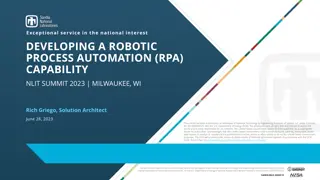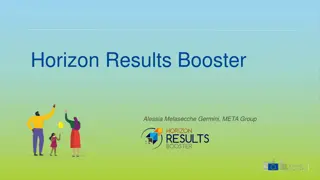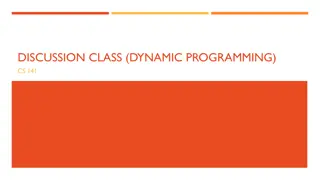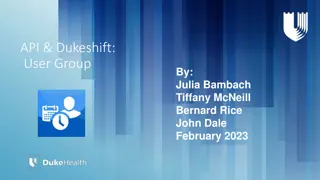Special Education Data Summit: Maximizing Data for Impactful Education Practices
Enhance your understanding of data utilization in special education through insights shared at the 2019 Special Education Data Summit. Dr. Jody A. Fields presents crucial aspects of data collection, management, and reporting, emphasizing the significance of accurate information for constructive decision-making in educational settings.
Download Presentation

Please find below an Image/Link to download the presentation.
The content on the website is provided AS IS for your information and personal use only. It may not be sold, licensed, or shared on other websites without obtaining consent from the author.If you encounter any issues during the download, it is possible that the publisher has removed the file from their server.
You are allowed to download the files provided on this website for personal or commercial use, subject to the condition that they are used lawfully. All files are the property of their respective owners.
The content on the website is provided AS IS for your information and personal use only. It may not be sold, licensed, or shared on other websites without obtaining consent from the author.
E N D
Presentation Transcript
WELCOME 2019 Special Education Data Summit Presented by Dr. Jody A Fields, Director IDEA Data & Research, UA Little Rock jafields@ualr.edu
Housekeeping Please MUTE your phones If you need to take a call go out of the room Keep the side conversations to a minimum Log into KAHOOT.it Crenisha will give us the pin number We will be playing trivia throughout the presentation with prizes
What do we do with all the data LEAs submit? Presented by: Jody A. Fields, Ph.D. 2019 Special Education Data Summit, August 21, 2019 Holiday Inn Airport Conference Center, Little Rock, AR
Where did those numbers come from? eSchool MySped Resource Monitoring Findings Finance Dispute Resolution (complaints/hearings) Etc
Collecting and reporting data can be tedious and often dispassionate work, but the task is not without ramifications.
Accurate data is vital to the collection process. One needs to understand the data being requested; Who collects the data; and Where the data can be found
Every aspect of our lives is the subject of some data collection. Do you live in a urban, suburban, or rural community Wages Watching TV Type of vehicle you drive Employment Status Being born dying
Every dataset collected has its own process. What is being collected? How is it being collected? Parent registering their child for school would include demographic data Who is collecting the information? Is there a set form so the collection is uniform across buildings? Has the person been trained on collecting the information? Does the person understand what is being collected
Every dataset collected has its own process. Where is that information stored? Paper/Electronic Who keeps the paper file? Who enters the information into the electronic system? Is it someone different than the person collecting the data? Has that person been trained to use the electronic system When is the data submitted? Cycle 2-7 CRDC Civil Rights Data Collection Family Surveys
THE 4 Cs of TIMELY AND ACCURATE DATA SUBMISSIONS CONCISE TIMELY AND ACCURATE DATA SUBMISSIONS CLEAR COMPLETE CORRECT
DATA SUMMIT OBJECTIVES Objective of this Data Summit is to provide LEAs with a better understanding of Where the data comes from How the data are collected at the State level How the data LEAs submit are used in various reporting requirements
Trivia 1 Which two sections of IDEA requires reporting of data. A. Section 616 and 618 B. Section 613 and 616 C. Section 619 and 618 D. Section 611 and 619
Federal Reporting Requirements in IDEA Section 618: Section 618 of the Individuals with Disabilities Education Act (IDEA) requires that each state submit data about the infants and toddlers, birth through age 2, who receive early intervention services under Part C of IDEA and children with disabilities, ages 3 through 21, who receive special education and related services under Part B of IDEA. Section 616 (b): Section 616(b) of the Individuals with Disabilities Education Act (IDEA) requires that each state submit a State Performance Plan with rigorous targets and submit an Annual Performance Report based on the targets
IDEA Section 618 Federal Reporting Requirements School Age Child Count and Educational Environment Early Childhood Child Count Educational Environment School Age MOE/CEIS School Age Exits School Age and Early Childhood Special Education Personnel School Age and Early Childhood Special Education Discipline Dispute Resolution Statewide Assessment
Trivia 2 Which data sets are due to the US Department of Education on the first Wednesday in April? A. Child Count and Environment B. Child Count, Environment, and Personnel C. School Age MOE/CCEIS D. Personnel
IDEA Section 618 Federal Reporting Requirements First Wednesday in April School Age Child Count and Educational Environment Early Childhood Child Count Educational Environment First Wednesday in May School Age MOE/CEIS First Wednesday in November School Age Exits School Age and Early Childhood Special Education Personnel School Age and Early Childhood Special Education Discipline Dispute Resolution Mid-December Statewide Assessment
IDEA Section 618 Federal Reporting Requirements Cycle 4 School Age Child Count and Educational Environment Early Childhood Child Count Educational Environment School Age and Early Childhood Special Education Personnel Cycle 7 School Age Exits School Age and Early Childhood Special Education Discipline Dispute Resolution School Age MOE/CCEIS Assessment is post-appeal data finalized in Fall.
School Age Child Count and Environments Data Sources: SIS Cycle 4 submission period December 1-15 Source Data: eSchool, MySped Resource (non-eSchool State Agencies) Data is based on special education module s entry date. Submitted at the State, District, and School Building level Race/Ethnicity Gender Disability Category Age (on December 1) Educational Environment LEP Status Federal submission deadline: First Wednesday in April
Early Childhood Child Count and Environments Data Sources: SIS Cycle 4 submission period December 1-15 Source Data: eSchool Data is based on special education module s entry/withdrawal dates. Submitted at the State and District level Race/Ethnicity Gender Age (on December 1) Disability Category Educational Environment LEP Status Federal submission deadline: First Wednesday in April
School Age Maintenance of Effort/Coordinated Early Intervening Services Data Sources: SIS Cycle 7 submission period June 1-15. Early Intervening Services Module in eSchool (students served) ADE Finance 619 and 611 Allocations Special Education Finance amounted budgeted for CCEIS/CEIS APR Determinations Child Count Federal submission deadline: First Wednesday in May
School Age Maintenance of Effort/Coordinated Early Intervening Services This report is submitted at the District level and includes the following State allocation for each district for the past two years includes a breakdown between 611 (school age) and 619 (early childhood) funds Annual Performance Report Determinations and year of data used District flags for a reduction of state and/or local funds MOE determination status; did the district meet MOE; were non-federal funds returned; amount of non-federal funds returned. District flags for mandated CEIS and Voluntary CEIS Area of Disproportionality (Identification, Disability, Educational Placement, and/or Discipline) if mandated district District budgeted amount for CEIS Mandated must equal 15% of allocation (611 and 619) Voluntary up to 15% of allocation Number of students served under CEIS (mandated and voluntary) Number of students served during the last 3 years who were placed into Special Education
School Age Exits Data Sources: SIS Cycle 7 submission period June 1-15. School age module in eSchool and MySped Resource for non- eSchool state agencies Students ages 14-21 Submitted at the State and District level Race/Ethnicity Gender Disability Category Age (on December 1) Basis of Exit LEP Status Federal submission deadline: First Wednesday in November
School Age & Early Childhood Personnel Data Sources: SIS Cycle 4 submission period December 1-15. Special Education Employee module in eSchool and MySped Resource for non-eSchool state agencies Federal submission deadline: First Wednesday in November. Three files are submitted at the state and district levels Teachers: fully certified/not fully certified by EC and SA Paraprofessionals: fully certified/not fully certified by EC and SA Related Service Providers: fully certified/not fully certified by EC and SA
Trivia 3 Besides the assessment files, which data set(s) is submitted at the building level? A. Early Childhood Child Count and Environment B. Personnel C. School age Child Count and Environment D. All data sets
School Age and Early Childhood Discipline Data Sources: SIS Cycle 7 submission period June 1-15. eSchool Discipline module and MySped Resource for non-eSchool state agencies Federal submission deadline: First Wednesday in November. Five files are submitted at the state and district level Removal to Interim Alternative Educational Setting Suspension/Expulsion (ISS and OSS, > 10 days, 10 days or less) Reasons for Unilateral Removals (guns, drugs, etc) Disciplinary Removals Total Disciplinary Removals
Statewide Assessment Data Source: Post-appeal cleaned data for the Office of Innovation in Education at UA- Fayetteville Contractor for ADE to handle assessment data from start through appeals and accountability APSIRE, DLM Federal submission deadline: Mid-December for the CSPR Part I Six files are submitted at the state, district and school level for Math, ELA, and Science, respectfully. Each subject has a participation and performance file.
Trivia 4 How many indicators are reported on the Local Education Agency (LEA) Annual Performance Report? A. 9 B. 15 C. 11 D. 17
Section 616 of IDEA SEC. 616. <<NOTE: 20 USC 1416.>> MONITORING, TECHNICAL ASSISTANCE, AND ENFORCEMENT. (b) State Performance Plans.-- (1) Plan. (A) each State shall have in place a performance plan that evaluates that State's efforts to implement the requirements and purposes of this part and describes how the State will improve such implementation. (B) Submission for approval.--Each State shall submit the State's performance plan to the Secretary for approval in accordance with the approval process described in subsection (c). (C) Review.--Each State shall review its State performance plan at least once every 6 years and submit any amendments to the Secretary.
Section 616 of IDEA (2) Targets.-- (A) In general.--As a part of the State performance plan described under paragraph (1), each State shall establish measurable and rigorous targets for the indicators established under the priority areas described in subsection (a)(3). (B) Data collection.-- (i) In general.--Each State shall collect valid and reliable information as needed to report annually to the Secretary on the priority areas described in subsection (a)(3). (ii) Rule of construction.--Nothing in this title shall be construed to authorize the development of a nationwide database of personally identifiable information on individuals involved in studies or other collections of data under this part.
Section 616 of IDEA (2) Targets.-- (C) Public reporting and privacy.-- (i) In general.--The State shall use the targets established in the plan and priority areas described in subsection (a)(3) to analyze the performance of each local educational agency in the State in implementing this part. (ii) Report. (I) Public report.--The State shall report annually to the public on the performance of each local educational agency located in the State on the targets in the State's performance plan. The State shall make the State's performance plan available through public means, including by posting on the website of the State educational agency, distribution to the media, and distribution through public agencies. (II) State performance report.-- The State shall report annually to the Secretary on the performance of the State under the State's performance plan. (iii) Privacy.--The State shall not report to the public or the Secretary any information on performance that would result in the disclosure of personally identifiable information about individual children or where the available data is insufficient to yield statistically reliable information.
Trivia 5 Which 4 related indicators total 30 when you sum up their indicator numbers? A. Indicators 1, 2, 13, 14 B. Indicators 1, 3, 12, 14 C. Indicators 2, 4, 10, 14 D. Indicators 2, 4, 11, 13
Indicator 1: Graduation Results indicator: Percent of youth with IEPs graduating from high school with a regular diploma. (20 U.S.C. 1416 (a)(3)(A)) Calculation: The four-year graduation rate follows a cohort, or a group of students, who begin as first-time 9th graders in a particular school year and who graduate with a regular high school diploma in four years or less. The cohort is "adjusted" by adding any students transferring into the cohort and by subtracting any students who transfers out, emigrate to another country, or die during the years covered by the rate. Students can be identified into a subcategory anytime in their high school years.
Indicator 1: Graduation Historical Data and Targets 2005 2006 2007 2008 2009 2010 2011 2012 FFY Target 88.00% 89.00% 77.00% 77.00% 85.00% 85.00% 85.00% Data 87.49% 94.15% 90.18% 81.42% 81.42% 75.76% 75.31% 79.15% FFY 2013 2014 2015 2016 2017 2018 Target 85.00% 85.00% 85.00% 84.29% 85.10% 85.91% Data 80.44% 83.14% 81.89% 84.29% 83.80% FFY 2017 SPP/APR Data Number of youth with IEPs in the current year's adjusted cohort graduating with a regular diploma Number of youth with IEPs in the current year's adjusted cohort eligible to graduate FFY 2016 Data FFY 2017 Target FFY 2017 Data 3,379 4.032 84.29% 84.29 83.80
Indicator 2: Dropout Results indicator: Results indicator: Percent of youth with IEPs dropping out of high school. (20 U.S.C. 1416 (a)(3)(A)) Calculations: Option 1: States must report a percentage using the number of youth with IEPs (ages 14-21) who exited special education due to dropping out in the numerator and the number of all youth with IEPs who left high school (ages 14-21) in the denominator. (Cycle 7 Data) Option 2: Use the annual event school dropout rate for students leaving a school in a single year determined in accordance with the National Center for Education Statistic's Common Core of Data. Data for this indicator are lag data. Describe the results of the State s examination of the data for the year before the reporting year (e.g., for the FFY 2013 APR, use data from 2012-2013), and compare the results to the target. (Cycle 3 Data)
Indicator 2: Dropout Historical Data and Targets FFY 2005 2006 2007 2008 2009 2010 2011 2012 Target 2.83% 2.87% 4.28% 4.25% 4.20% 4.20% 4.20% Data 2.59% 3.51% 3.37% 4.28% 3.66% 3.06% 2.92% 2.62% FFY 2013 2014 2015 2016 2017 2018 Target 2.77% 2.62% 2.54% 2.29% 2.14% 1.98% Data 1.97% 2.03% 1.94% 1.60% 1.88% FFY 2013 SPP/APR Data Number of youth with IEPs (ages 14-21) who exited special education due to dropping out Total number of all youth with IEPs who left high school (ages 14-21) FFY 2016 Data FFY 2017 Target FFY 2017 Data 449 23,942 1.60% 2.14% 1.88%
Trivia 6 Early childhood has how many indicators reported in the LEA APR Report? A. 2 B. 6 C. 1 D. 7
Indicator 3: Assessment Results indicator: Participation and performance of children with IEPs on Statewide assessments: B. Participation rate for children with IEPs. C. Proficiency rate for children with IEPs against grade level, modified and alternate academic achievement standards.
Indicator 3B: Participation Rate for Children with IEPs Percent of the children with IEPs participating in the statewide assessment Provide separate reading/language arts and mathematics participation rates, inclusive of all ESEA grades assessed (3-8 and high school), for children with IEPs. Only include children with disabilities who had an IEP at the time of testing. Calculation: Participation rate percent = [(# of children with IEPs participating in an assessment) divided by the (total # of children with IEPs enrolled during the testing window, calculated separately for reading and math)]. The participation rate is based on all children with IEPs, including both children with IEPs enrolled for a full academic year and those not enrolled for a full academic year.
Indicator 3B: Participation Rate for Children with IEPs Historical Data and Targets FFY 2005 2006 2007 2008 2009 2010 2011 2012 Targets for Reading and Mathematics Participation 95.00% 95.00% 95.00% 95.00% 95.00% 95.00% 95.00% State Rate: Reading 96.56% 97.84% 98.62% 98.59% 99.12% 98.78% 98.81% 97.81% State Rate: Mathematics 96.56% 97.84% 98.62% 98.02% 98.88% 98.61% 98.61% 97.69% FFY 2013 2014 2015 2016 2017 2018 Target s for Reading and Mathematics Participation 95.00% 95.00% 95.00% 95.00% 95.00% State Rate: Reading 97.72% 97.15% 98.70% 98.81% 98.76% State Rate: Mathematics 96.91% 97.52% 98.91% 98.90% 98.83%
Indicator 3B: Participation Rate for Children with IEPs: Reading FFY 2017 Assessment Data Groups: Reading Reading assessment participation data by grade Grade 3 4 5 6 7 8 HS 5,375 5,234 5,248 4,952 4,671 4,392 7,832 a. Children with IEPs b. IEPs in regular assessment with no accommodations 977 626 458 320 278 302 644 c. IEPs in regular assessment with accommodations 3,821 4,038 4,171 4,087 3,885 3,544 6,510 f. IEPs in alternate assessment against alternate standards 544 550 581 510 460 480 452 FFY 2017 SPP/APR Data: Reading Number of Children with IEPs Number of Children with IEPs participating FFY 2016 Data FFY 2017 Target FFY 2017 Data Reading 37,704 37,236 98.81% 95.00% 98.76%
Indicator 3B: Participation Rate for Children with IEPs: Mathematics FFY 2017 Assessment Data Groups: Mathematics Mathematics assessment participation data by grade Grade 3 4 5 6 7 8 HS 5,375 5,232 5,251 4,953 4,673 4,395 7,839 a. Children with IEPs b. IEPs in regular assessment with no accommodations 979 626 458 319 278 301 645 c. IEPs in regular assessment with accommodations 3,824 4,036 4,180 4,090 3,891 3,555 6,524 f. IEPs in alternate assessment against alternate standards 542 548 581 511 459 480 450 FFY 2017 SPP/APR Data: Mathematics Number of Children with IEPs 37,718 Number of Children with IEPs participating 37,277 FFY 2016 Data 98.90% FFY 2017 Target 95.00% FFY 2017 Data 98.83% Mathematics
Indicator 3C: Proficiency rate for children with IEPs against grade level, modified and alternate academic achievement standards. Proficiency rate percent = ([(# of children with IEPs scoring at or above proficient against grade level, modified and alternate academic achievement standards) divided by the (total # of children with IEPs who received a valid score and for whom a proficiency level was assigned, and, calculated separately for reading and math)]. The proficiency rate includes both children with IEPs enrolled for a full academic year and those not enrolled for a full academic year.
Indicator 3C: Proficiency rate for children with IEPs against grade level, modified and alternate academic achievement standards. Historical Data and Targets FFY 2005 2006 2007 2008 2009 2010 2011 2012 Targets for Reading Proficiency 13.17% 19.58% 25.99% 32.40% 38.81% 45.22% 45.22% State Rate: Reading 14.62% 16.49% 19.95% 24.99% 27.20% 31.49% 36.06% 33.23% Targets for Mathematics Proficiency 18.54% 25.06% 31.58% 38.10% 44.62% 51.14% 51.14% State Rate: Mathematics 18.98% 24.81% 30.86% 38.29% 42.56% 44.86% 45.42% 42.09% FFY 2013 2014 2015 2016 2017 2018 Target s for Reading Proficiency 31.27% 30.29% 32.27% 34.23% 36.19% 38.15% State Rate: Reading 32.26% 10.45% 13.41% 14.38% 11.15% Targets for Mathematics Proficiency 40.13% 38.17% 37.19% 39.15% 41.11% 43.07% State Rate: Mathematics 40.56% 10.42% 16.00% 17.01% 15.88%
Indicator 3C: Proficiency rate for children with IEPs against grade level, modified and alternate academic achievement standards. FFY 2017 Assessment Data Groups: Reading Reading proficiency data by grade 3 Grade 4 5 6 7 8 HS a. Children with IEPs who received a valid score and a proficiency was assigned b. IEPs in regular assessment with no accommodations scored at or above proficient against grade level c. IEPs in regular assessment with accommodations scored at or above proficient against grade level f. IEPs in alternate assessment against alternate standards scored at or above proficient against grade level 5,342 5,214 5,210 4,917 4,623 4,326 7,604 370 245 170 112 59 55 83 159 174 146 192 146 190 222 288 248 297 246 250 225 274 FFY 2017 SPP/APR Data: Reading Children with IEPs who received a valid score and a proficiency was assigned 37,236 Number of Children with IEPs Proficient FFY 2016 Data FFY 2017 Target FFY 2017 Data Reading 4,151 14.38% 36.19% 11.15%
Indicator 3C: Proficiency rate for children with IEPs against grade level, modified and alternate academic achievement standards. FFY 2017 Assessment Data Groups: Mathematics Reading proficiency data by grade 3 Grade 4 5 6 7 8 HS a. Children with IEPs who received a valid score and a proficiency was assigned b. IEPs in regular assessment with no accommodations scored at or above proficient against grade level c. IEPs in regular assessment with accommodations scored at or above proficient against grade level f. IEPs in alternate assessment against alternate standards scored at or above proficient against grade level 5,345 5,210 5,219 4,920 4,628 4,336 7,619 565 320 207 129 85 61 50 444 504 467 645 242 175 178 291 232 300 286 239 249 250 FFY 2017 SPP/APR Data: Mathematics Children with IEPs who received a valid score and a proficiency was assigned 37,277 Number of Children with IEPs Proficient 5,919 FFY 2016 Data FFY 2017 Target 41.11% FFY 2017 Data 15.88% 17.01% Mathematics
Indicator 4: Suspension and Expulsion Results/compliance indicator: Rates of suspension and expulsion: A. Percent of districts that have a significant discrepancy in the rate of suspensions and expulsions of greater than 10 days in a school year for children with IEPs; and B. Percent of districts that have: a. a significant discrepancy, by race or ethnicity, in the rate of suspensions and expulsions of greater than 10 days in a school year for children with IEPs; and b. policies, procedures or practices that contribute to the significant discrepancy and do not comply with requirements relating to the development and implementation of IEPs, the use of positive behavioral interventions and supports, and procedural safeguards. Note: This measurement is for all students in K-12.
4A: Suspension and Expulsion Measurement: Percent = [(# of districts that have a significant discrepancy in the rates of suspensions and expulsions for greater than 10 days in a school year of children with IEPs) divided by the (# of districts in the State)] times 100 Has the State Established a minimum n-size requirement? Yes No The State may only include, in both the numerator and the denominator, districts that met the State-established n size. Report the number of districts excluded from the calculation as a result of the requirement. 221 (204 districts; 15 charter schools, and two outside of education state agencies) This is a hybrid indicator. Part I: Identify districts as having a significant discrepancy. Rate of students receiving out- of-school suspensions/expulsion totaling greater than 10 days. Rate of special education Rate of general education If special education s rate is 1.36 percentage points higher than general education s rate then the district is identified as having a significant discrepancy.
4A: Suspension and Expulsion Part II: Compliance If the district is identified as having a significant discrepancy they Must complete a review of their policies, procedures, and practices via the Special Education Disproportionality Self-Assessment tool Submit the tool the their ADE Special Education Area Supervisor District will receive notification of acceptance or non- acceptance of self-assessment content.
Indicator 4A: Percent of districts that have a significant discrepancy in the rate of suspensions and expulsions of greater than 10 days in a school year for children with IEPs Historical Data and Targets FFY 2005 2006 2007 2008 2009 2010 2011 2012 Target 7.59% 7.11% 7.11% 7.00% 6.23% 6.23% 6.23% Data 9.06% 7.57% 11.76% 11.76% 7.86% 6.91% 10.26% 3.69% FFY 2013 2014 2015 2016 2017 2018 Target 5.77% 5.43% 5.11% 30.14% 30.00% 29.50% Data 4.65% 4.67% 7.00% 30.14% 18.97% FFY 2017 SPP/APR Data Number of districts that have a significant discrepancy FFY 2016 Data FFY 2017 Target FFY 2017 Data Number of districts in the State 11 58 30.14% 30.00% 18.97%
Trivia 7 There are 3.5 indicators that address disproportionality; What are the indicator numbers? A. Indicators 4a, 4b, 9 and 10 B. Indicators 4a, 4b, 11 and 12 C. Indicators 3a, 3b, 9 and 10 D. Indicators 3, 4, 9 and 10























